How Does TV Advertising Work?
During 2020—despite widespread economic turmoil—1,243 UK businesses saw the advantages of TV advertising and went on air for the first time. But why would so many advertisers choose to add an additional untested advertising channel to their marketing spend during such uncertain times?
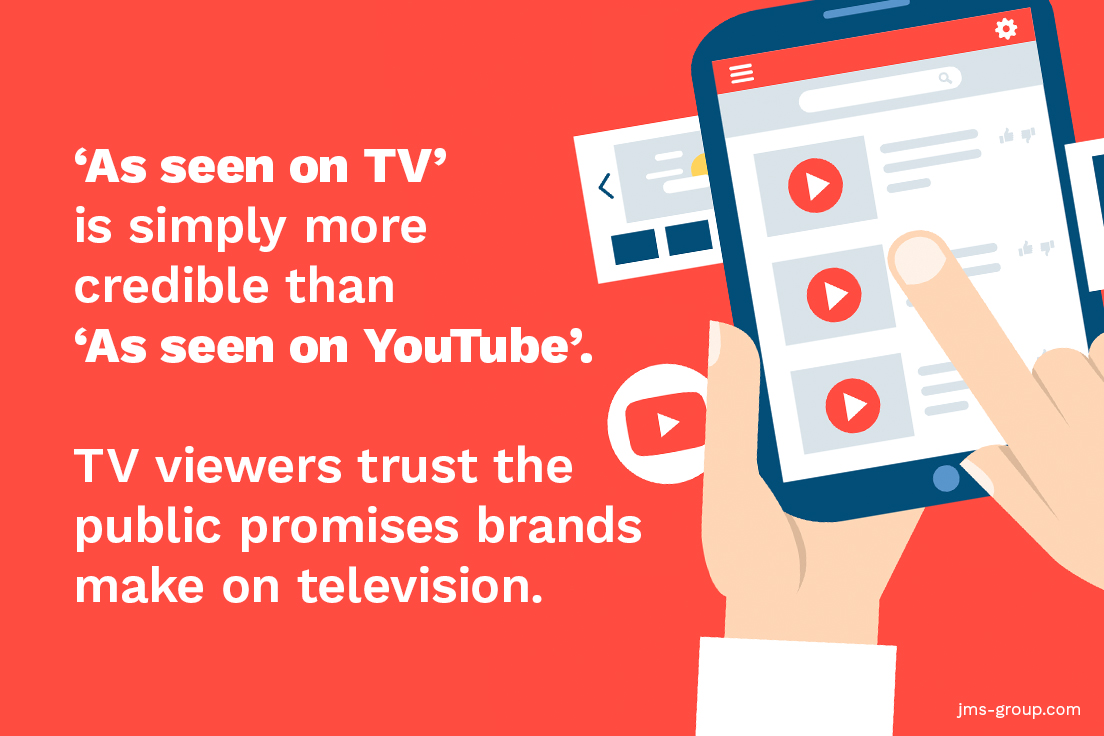
How does TV advertising work? Simple: It’s the most credible! Illustration by Freepik
- Why Advertise on Television?
- Does TV Advertising Work?
- Television Builds Brands!
- The Problem With Ads on Video Sharing Sites
- What Is Linear TV?
- What Is Addressable TV?
- How Much Does It Cost to Advertise on TV in the UK?
- How Much Does a TV Commercial Cost?
- How to Make a Professional TV Commercial
- How Long Does It Take To Make a TV Commercial?
- What Is Clearcast, and What Is Clearcast Approval?
- How to Produce a TV Commercial
Why Advertise on Television?
Simple: Television campaigns are effective; they provide a dependable return on investment for advertisers, and television advertising remains the public’s most trusted advertising channel— both extremely valuable attributes during risky times.
So… TV Isn’t Dead?
TV has continued to be the medium people spend the most time with. Commercial television’s popularity has endured, no mean feat considering ITV aired the UK’s first television commercial in 1955. Incidentally, the first product to be advertised on TV was toothpaste, a consumer product that has remained loyal to TV ever since.
Broadcast TV accounts for 91% of the video-based advertising seen by all adults in a single day, and a healthy 77% for 16-34s. While traditional (aka. ‘linear’) TV has experienced a decline in viewership over the past decade, the slack has been picked up by Broadcaster Video-On-Demand (BVOD) apps. The viewing time of ads delivered via BVOD climbed 22% during 2020. On-demand programming reaches those younger, lighter viewers who have drifted away from traditional fixed-time TV viewing. Incidentally, BVOD ads are every bit as effective as linear TV ads, sometimes even more so.
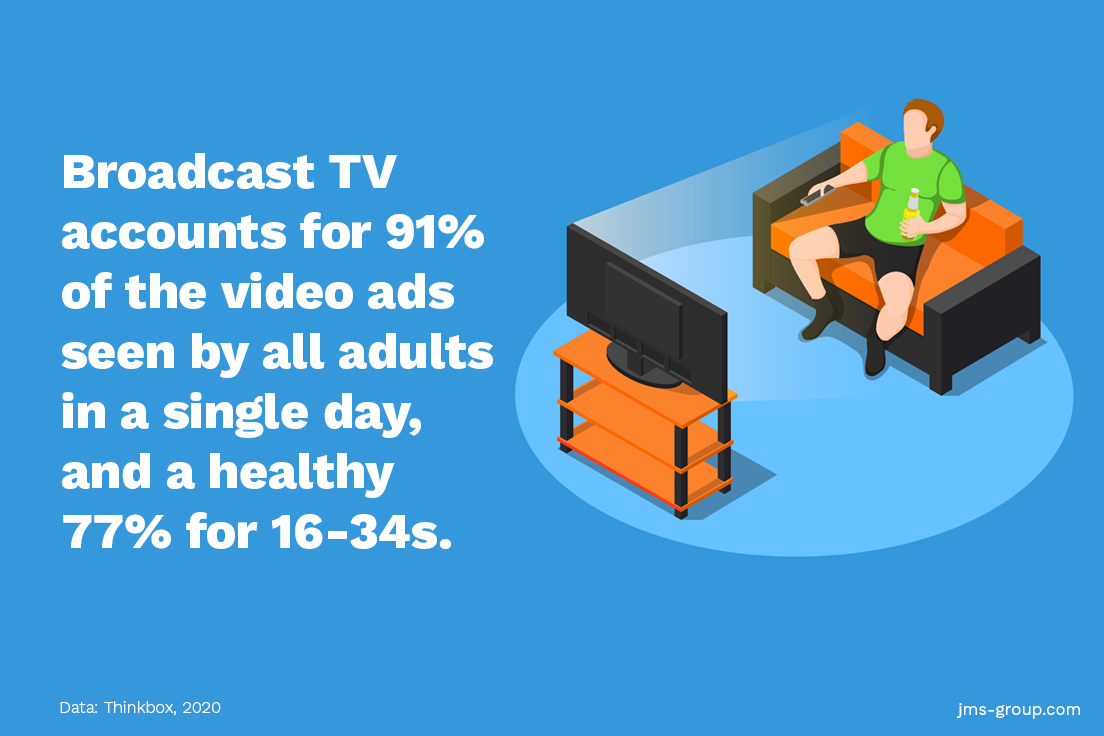
Is TV Dead? Nope. We still watch a LOT of TV! Illustration by Freepik
Even the explosive growth of Subscriber Video-On-Demand (SVOD) services such as Netflix or Amazon Prime hasn’t severely impacted commercial services, the amount of entertainment we watch is up across the board. Watching a lot of programming inevitably means each of us is exposed—on average—to 41 TV commercials per day; but that’s a trade most viewers are happy to make in exchange for free high-quality entertainment. Do some viewers skip the ads? Sure, a small number do. Despite what cynics might have you believe; most TV viewers do not go to the additional effort to avoid ad breaks.
To put television’s share of our viewing day into a wider context, the video content behemoth YouTube takes only 5.6% of the video ad pie (a more substantial 15.5% among 16-34), with new kid TikTok displaying 1.4% of the video ads viewed per day. While Facebook serves video ads, it’s slice of the average day’s viewing is too small to be accurately measured.
Does TV Advertising Work?
Yup! Television advertising is still extremely effective!
TV is a wildly effective medium for all sizes of brands, and it can efficiently create sales uplift even at relatively low levels of investment (we’ll delve into TV advertising costs later). Television advertising has a stronger proportional effect for smaller brands; small brands are working from a lower baseline and are often communicating products or services that are entirely new to viewers.
TV starts delivering sales results from the first week of a campaign, and that uplift can sustain for 3-6 months after a campaign has finished. An average 4-week campaign can build to a weekly sales uplift of around 25%, with the profit payback point arriving at around month 4*.
TV is also the medium of choice for advertisers specifically wanting to drive online traffic. Online-only businesses are television’s biggest-spending category, and they invested almost £800m to advertise on television in 2020! One of the mammoth advantages of TV advertising is its proven ability to drive search traffic; TV impressions will directly correlate to uplifts in your brand-name search.
*Supercharge: TV Advertising for Small Businesses, May 2019, Data2Decisions/Work/Thinkbox. Data2Decisions database of smaller brands. All categories. Based on campaign spend of £1.25m.
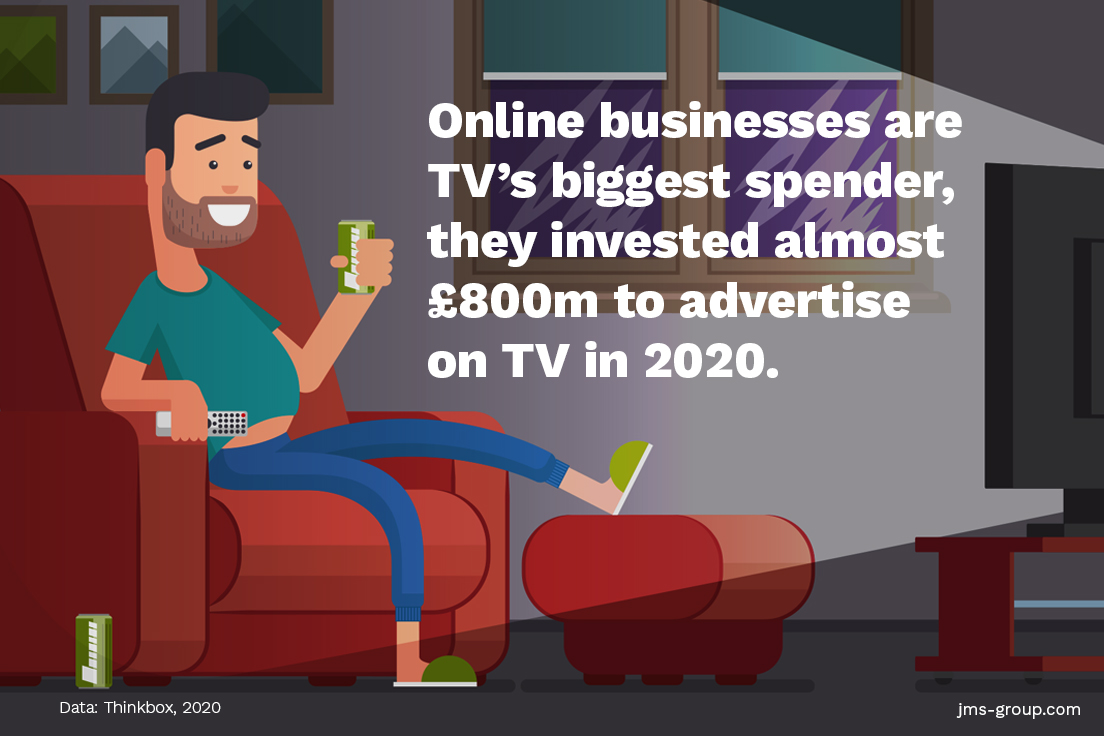
Online-only brands are TV’s biggest spending category. Illustration by macrovector / Freepik
Even during a year when many advertisers deferred or cancelled campaigns, the UK’s advertisers still spent a whopping £4.35bn on television airtime. While TV spend by ‘bricks and mortar’ high street retailers temporarily slumped, 2020 saw a surge in spending by FMCG brands. TV delivers 87% of all advertising-generated profit for FMCG brands (2017 Ebiquity ROI campaign database).
But of course, you don’t only want an immediate sales uplift: You’ll want to shape public opinion of your brand and build long-term reputation and memorability.
Television Builds Brands!
‘Signalling Success’ is a 2020 study conducted by TV advertising’s marketing body Thinkbox, in conjunction with house51. The key findings of their study highlighted the trust that viewers place in television when forming an opinion of a brand:
1. Television advertising drove the strongest fitness and social signals in all categories tested. TV outperformed social media and online video across every category.
Fitness signals are about financial strength, product confidence, and quality. Social signals are about fame, popularity, and success. Social media and video sharing sites were the advertising channels least likely to drive these signals. TV delivered stronger fitness and social signals for all age groups, including younger audiences.
2. Brands that chose to advertise on television were significantly more likely to be perceived as financially strong, confident, and of high quality.
TV’s ability to drive fitness signals outperformed all other media tested: 36% stronger than the average. Half of all respondents rated brands that advertise on television as financially strong.
3. TV helped brands convey popularity and success more than any other medium.
TV was 23% stronger than average in delivering social signals. Half of all respondents believed that advertising on television meant lots of other people were buying the brand.
4. Brands advertising on TV, in magazines, and on radio are perceived as the most trusted to deliver on promises.
30% trusted TV advertising to deliver on the promises made, making TV the most trustworthy medium, just ahead of magazines (29%) and radio (28%). Advertising on video sharing sites was the least likely to deliver brand trust, with only 19% of respondents placing trust in the claims of advertisers.
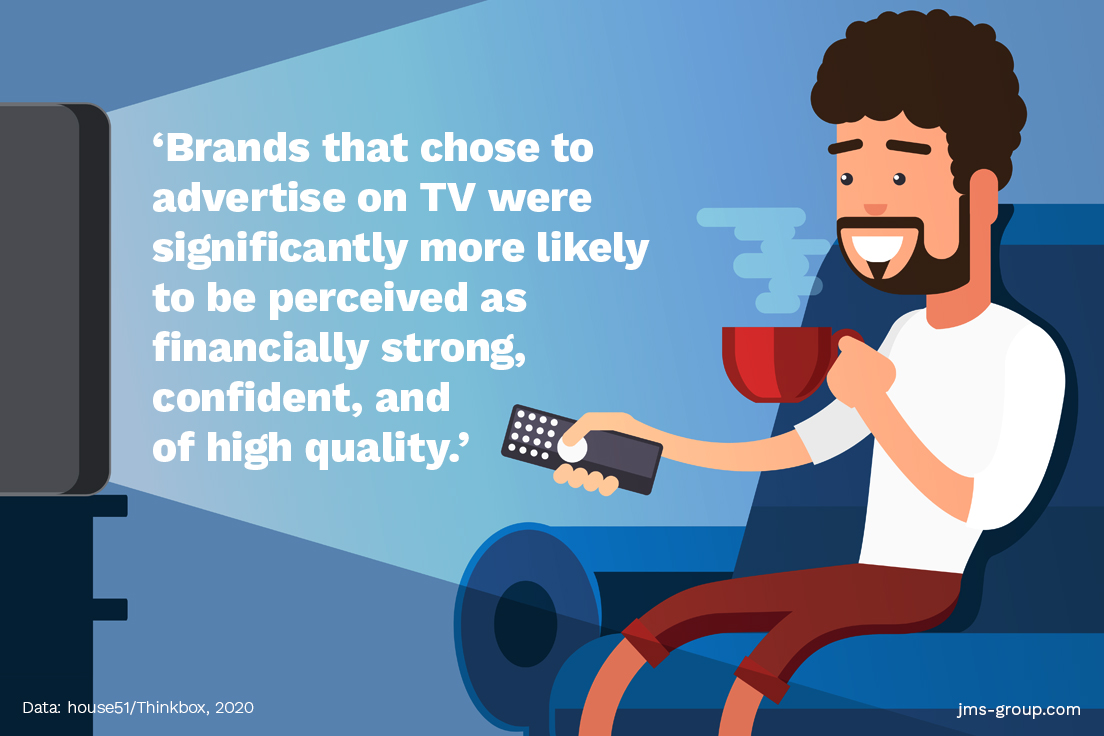
Brands that advertise on television are perceived to be of high quality. Illustration by macrovector / Freepik
The Problem With Ads on Video Sharing Sites
Okay: The stats for public trust of ads on video sharing sites don’t look too hot, but let’s be fair to online advertising for a moment; a great number of businesses thrive using Google Ads (the PPC platform running the video ads on YouTube) and there is very often a place for video ads within a campaign mix.
Let’s say you’re the owner of a business that operates a DTC dog-treat subscription service, and you offer free shipping across mainland Europe. You have a ‘first-month free’ call to action, and a click-thru from the ad would drop your potential customer directly into a sign-up page. I’d wager that targeting a YouTube TrueView (in-stream) ad at people watching dog-grooming or dog-training videos from a European IP address could be a good call when paired with television advertising and OOH (Out Of Home) to build brand-recognition in the countries with the greatest market potential. Solid campaign strategy.
Now suppose you’re a dealership selling high-performance cars to affluent individuals. My gut feeling is that placing in-stream ads on videos that are popular with petrol-heads would trigger many impressions, because car videos are a popular genre. However, those impressions will be unlikely to convert into clicks that lead to sales. Sure, your ads will be seen by people with an interest in high-performance cars, but without being able to target the campaign using accurate data on household income, car ownership, or postcode (Zip code) you’ll not know whether those impressions are being made to high net-worth individuals or to teenagers who enjoy watching drifting videos and playing Grand Theft Auto. It is anybody’s guess as to whether the clicks you pay for are coming from individuals with the intent or means to buy.
Writing purely from the perspective of a guy who has spent more than twenty years working in television advertising, online video campaigns raise four potential concerns (especially if it is being used as a standalone advertising channel):
1. Ad placement is highly dynamic.
It can be tough to grow brand recall through repeated impressions when your campaign is being adjusted by an algorithm-based bidding system. You can control a lot of the parameters for your campaign, but ultimately, the system doesn’t answer to you. You might only get one-shot at the click.
2. You don’t know whose company you’re in.
The internet is full of unsavoury and even illegal content; and much of it can be monetized by ads: potentially your ad.
3. Online advertising has a worryingly low barrier to entry.
All of us see enough clickbait ads to grasp that any scammer with a credit card can fund an advertising campaign. Accordingly, viewers of ads on video sharing sites have relatively low expectations of the credibility of advertisers.
4. Potentially lower quality of leads.
From my own experience of running various types of PPC campaigns—the process has been akin to writing our phone number in a bathroom stall. The number of impressions would be high; but of the tiny number of clicks we would receive, 99.9% of the resulting contacts were either tyre-kickers or outright weirdos.
Let’s be frank: With online advertising, it is often only after the money has been spent that you gain any kind of idea who your message has been reaching.
But, isn’t the same true of television advertising?
Well…yes, and no. Television advertising comes in two varieties: Linear, and Addressable.
What Is Linear TV?
Linear TV reaches large audiences of viewers, and TV commercials are placed by making educated judgements about the demographics that each show—or genre of programming—is most likely to attract. Scheduling of ads can also take advantage of the time of day, and the geographic transmission areas (which loosely align with UK regions).
The traditional broadcast model casts the net wide in the knowledge there will be some wastage, but that the intended demographic will have been reached within that broader audience (and that there will likely be some out-of-demographic viewers that also respond to the ad). This is a proven methodology that has been refined to a form of art by broadcasters and media planners, but—essentially—the underlying premise has not changed much since businesses were first given the opportunity to advertise on ITV in the 1950s.
Linear TV campaigns can be exceptionally powerful, especially for national brand-building and FMCG promotions with broad consumer appeal. But for a smaller first-time TV advertiser with a niche-interest product a linear campaign can be a sledgehammer to crack a nut.
What Is Addressable TV?
Addressable TV is quite simply the greatest development in the history of advertising, ever! Okay, a slight exaggeration, but it is cool.
Addressable TV takes advantage of the fact that modern entertainment services require the viewer to activate a subscription of some type; telling the broadcaster or streaming service plenty of information about who is on the receiving-end of their content. In the case of Sky and Virgin Media (that provide hardware and telecoms services to their subscribers) there is a legal contract between the broadcaster and the household. The broadcasters near-enough know exactly who is watching their programming.
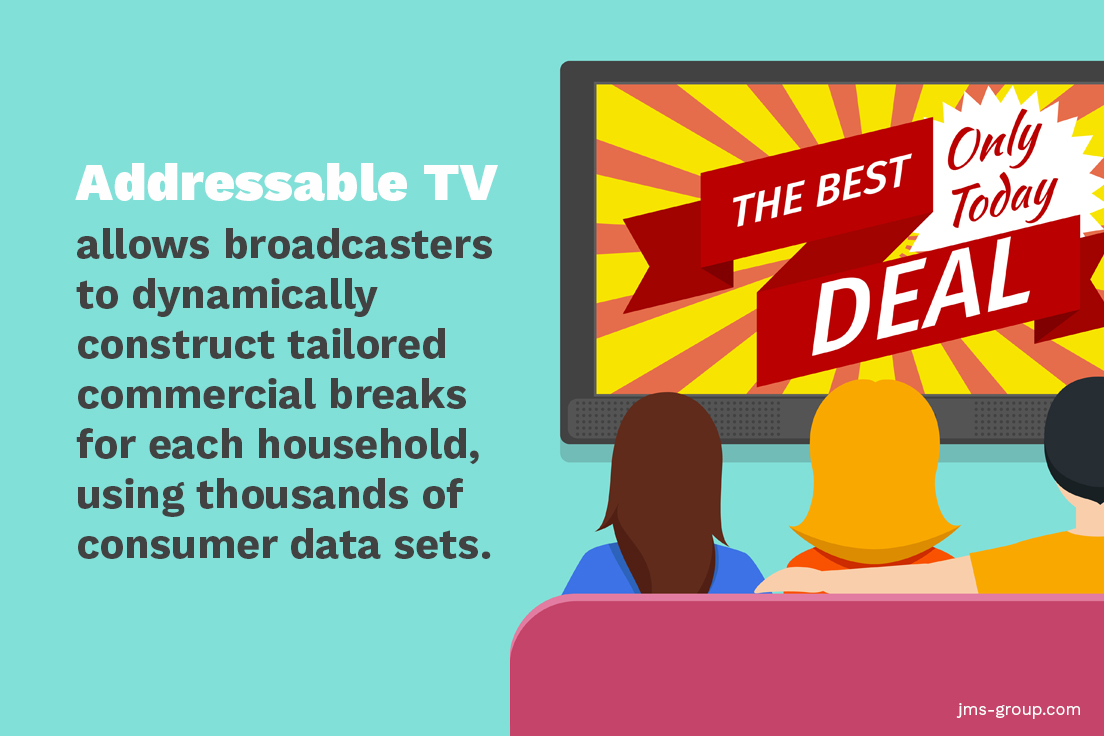
What is Addressable TV? Illustration by macrovector / Freepik
The dominant addressable TV platform in the UK is Sky’s AdSmart which launched in 2014, and the AdSmart platform also serves ads in Virgin Media homes. (ITV and its BVOD service ITV Hub use a comparable addressable advertising solution). The set-top boxes in viewers’ homes can then be used to dynamically construct custom playlists of ads, seamlessly creating bespoke ad-breaks for the household. The most appropriate ads to display are selected by blind-matching detailed consumer datasets (such as Experian: detailing income, property value, number of cars, age of dependents, supermarket spend, and household debt to name just a few) together with first-party data (such as viewing habits and device usage) collected by the broadcaster.
One of the cool features of AdSmart is that suitable commercials will be triggered in the household regardless of the channel or programming being viewed. Because the commercial is seamlessly inserted into the video stream even the smallest advertiser can (from a viewer’s perspective) appear to have bought a spot in a prestigious hit show.
How Much Does It Cost to Advertise on TV in the UK?
TV advertising has prestige and is widely regarded to be a cut above the rest (which is why it’s so great for building brands) but this positive attribute might also account for a lingering belief that television advertisers are part of an exclusive club, open only to those with vast marketing budgets.
In 2020, 888 advertisers invested less that £50k on their television campaigns, and almost 60% of all advertisers spent less than £250k. Big spenders were in the minority, only 25% of advertisers spent over a million pounds, and a mere 4% spent over £10m.
So, if your budget is on the smaller side, you’re in good company!
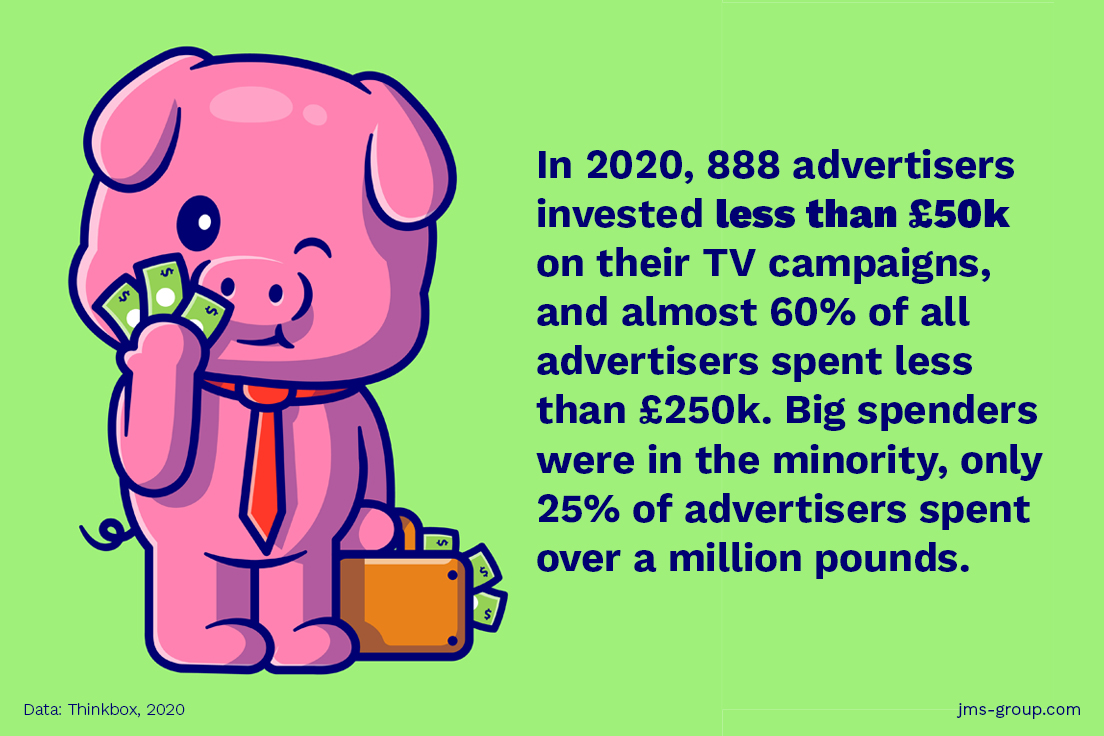
How much does it cost to advertise on TV in the UK? Illustration by catalyststuff / Freepik
The average cost of buying the media space to enable one person to see a TV advert once costs just over half a penny. That said, every channel has a ratecard, and it will be based on supply and demand.
Having an ad shown nationally on ITV during ‘peak’ (aka ‘primetime’) might cost between £10,000 and £35,000 dependent on the programming. If you want an ad in the final of I’m a Celebrity or Love Island it’s potentially going to come with a bigger price tag.
Meanwhile, a similar peak-time slot on ITV3 might start at £600. Comedy Central comes in at just £50. Or, if your audience are gripped by an especially eclectic mix of archive programming, a peak slot on Forces TV starts at £3 (yes, three quid).
If you only need to show your commercial within one or two regions the ratecard (even at peak) will be significantly lower. And if you show your ad during the day (popular for DRTV) the cost will be lower still!
I’ll circle back to buying TV airtime later, but for now just keep in mind that ratecard prices are just an indicator of the prices channels can command during different dayparts.
AdSmart brings the entry level cost for an entire television campaign down to just £3,000. Naturally, there are a great number of variables involved that can make that low baseline cost scale quite significantly. We have produced a lot of campaigns for AdSmart, and our clients have found the investment sweet spot is around £10k to £15k. To put those figures in context, placing a full-page ad in a national newspaper (for just one day) is going to cost between £30,000 to £60,000. In that light, the cost of television advertising is far from prohibitive, and it provides astounding value for money.
How Much Does a TV Commercial Cost? Could I Make One Myself?
Unfortunately, I’m going to have to disappoint you and be rather vague: There is no average cost of TV commercial production. The creation of a commercial will be tailored to the requirements of the campaign. That said, TV ads don’t necessarily need to be extravagant or overly artistic, they simply need to serve a purpose. As legendary ad-agency founder David Ogilvy wrote in his 1983 book Ogilvy on Advertising, “When I write an advertisement, I don’t want you to tell me that you find it ‘creative.’ I want you to find it so interesting that you buy the product.”
The cost of making a TV commercial doesn’t necessarily correlate with its effectiveness. That said, every commercial must meet a certain benchmark of quality to be able to perform its duty effectively. So, I would not recommend trying to go it alone; not least because the TV commercial regulations in the UK are especially stringent. Wayward commercials produced without adhering to the rules cannot be aired. I’ve picked up the pieces for several advertisers that had embarked on the self-production journey and been forced to turn back.
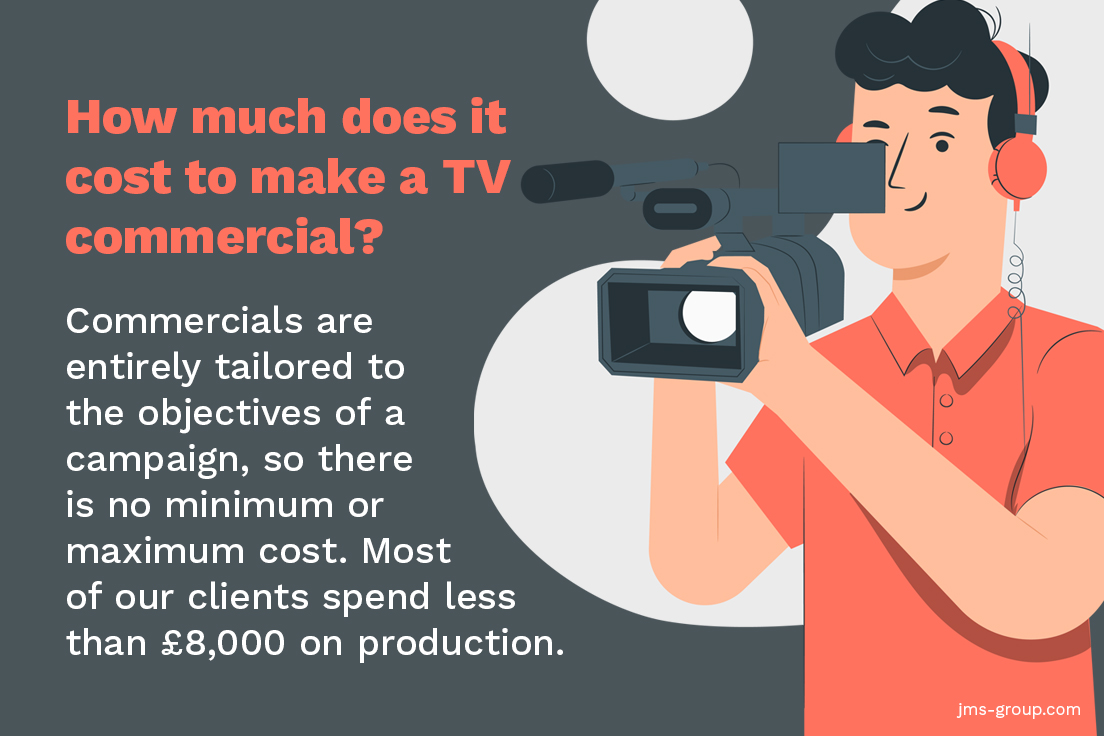
How much does it cost to make a TV commercial? Illustration by macrovector / Freepik
I recently pitched to a client who had already jumped the gun and spent thousands producing a commercial with a script that broke numerous ASA (Advertising Standards Authority) guidelines. To the client’s surprise (and horror) their commercial was refused clearance to air on TV, and it was beyond any editor’s rescue. The money invested had to be written-off, and it was back to the drawing board.
How much more would it have cost to have done it right? Nothing at all. Any experienced commercial production company will make sure the script is totally watertight and cleared prior to production as a matter of course.
Producing the ad to the correct technical specification, booking airtime, and delivering the finished commercial—with its scheduling information—to multiple broadcasters can be a complex undertaking. Sure, some major advertisers use TV so frequently their in-house creative team will learn how to handle the process themselves. Most advertisers simply opt to save themselves headaches and work with experienced TV advertising agencies and commercial production companies that are clearing and delivering ads daily.
How to Make a Professional TV Commercial
First: Define the Type of Campaign You Want to Run
What are your objectives? To sell more stuff? Okay, I am about to blow your mind! Not all the commercials you see are trying to sell you something—at least, not right away. TV commercials (frequently abbreviated to TVCs in advertising circles) come in three varieties:
Branding Campaign
Brand commercials are beloved of big business because they help shape public perceptions of the brand. Think of almost any commercial for a bank, car manufacturer, or price comparison site; they are all exercises in brand recognition and recall (what advertising folks call ‘front of mind’). Brand ads rarely delve into pricing or the gritty details of the product or service, they usually have high production values: impressive visuals, celebrity endorsement, or a chart-topping music track.
Those achingly sentimental 60-second ads for supermarkets and big retail stores around the festive season: 100% about branding! So, what do they achieve? Simple: They make viewers receptive to other messages in the campaign. Brand-building ads are especially useful for attracting attention to new-to-market brands. I recently produced and directed a stop motion TV commercial production for an auto rescue brand that wanted to position themselves as providing affordable breakdown cover for families. A special offer price was shown in the commercial, but the main intention of their TV debut was to stand apart from the branding of competitors in the market.
Activations
Activation ads prompt viewers to act. Activations are often delivered around the same time as an advertiser’s branding commercial. The soppy 60-second festive commercial I mentioned will be accompanied in the campaign by a flurry of straightforward 10 or 20-second commercials featuring little more than products and prices.
When a commercial for a familiar brand contains a limited-time offer or a ‘Was-Now’ price, it is almost certainly an activation ad. The advertiser’s identity needs no introduction as it is already ‘front of mind’, the brand commercial has already done the heavy lifting, allowing the activation ads to do their job: getting stuff sold!
DRTV Campaign
What is DRTV advertising? The literal meaning is Direct Response Television; but the definition is a little vague. In a sense, DRTV is a hybrid between branding and activation in that the commercial usually introduces a brand that is likely unknown to the viewer, while also trying to get them to take immediate action or to make a purchase.
‘Direct Response’ refers to the action a viewer should take. Traditionally the desired response would have been to call a freephone number, but DRTV campaigns are now almost exclusively designed to drive traffic to a website, or prompt brand-name search; something television advertising does exceptionally well.
If you are a new-to-TV advertiser aiming to grow brand recognition, while also getting an immediate ROI, a well-executed DRTV campaign is a powerful advertising tool.
Now that you know the three types of TV advertising, I guarantee you will immediately spot the advertiser’s intent behind every commercial in the break!
Second: Design Your Media Plan
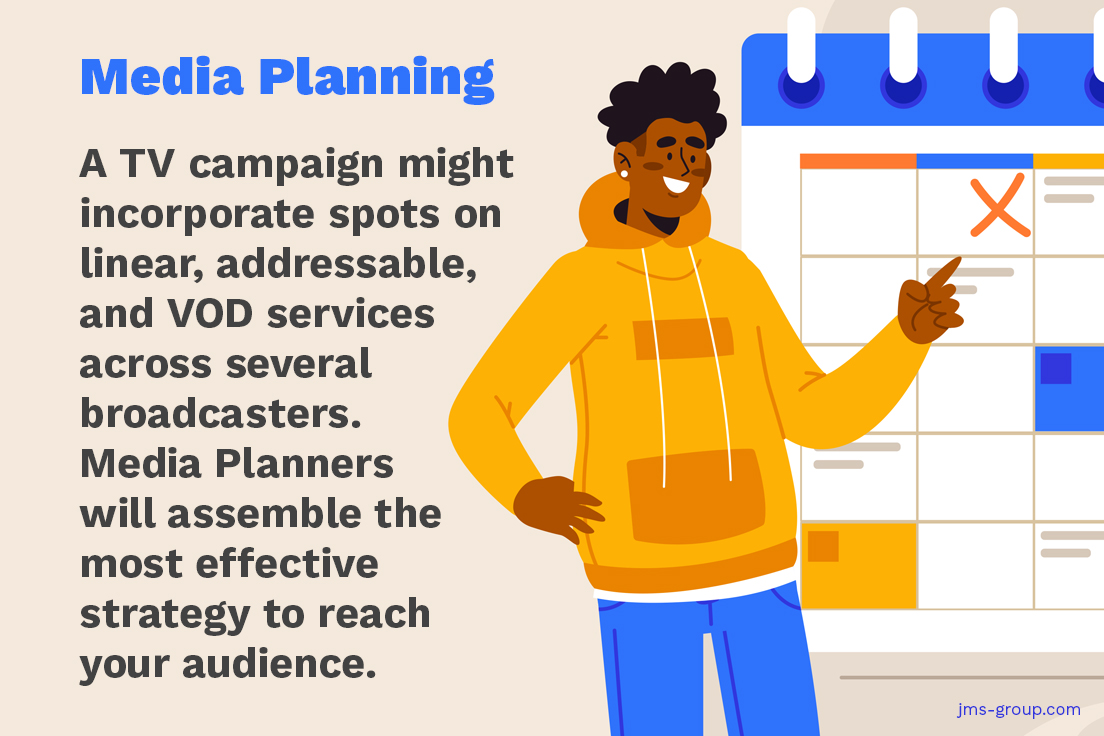
How does TV advertising work: What does a Media Planner do? Illustration by pikisuperstar / Freepik
It is possible to reach any given market with TV, not only because of TV’s scale but because of the infinite variety of entertainment now available. While primetime drama and ‘black shiny floor’ shows with studio audiences are still a family-friendly staple of British television, there is also an endless choice of niche-interest channels, and a vast back-catalogue of series available on-demand: and they could all be vehicles to deliver a commercial to your marketplace.
I’ve been in the TV advertising business for more than twenty years, and I still get a headache even thinking about media planning and buying airtime. It is a dark art, best left to those who know what they are doing!
Media Planning / Buying Agencies
These can be wholly independent businesses that specialise in booking the media for a campaign, or they might be contained as a department within an advertising agency. Whatever the setup, a media agency will be able to mix and match a load of media besides TV; they can expand your campaign into programme sponsorship, cinema, social media, out of home, newspapers, tube platforms, and anywhere else you can think of putting advertising!
Media agencies have channel experience. They know which platforms work best to reach specific audiences, and they can also negotiate the best prices based on volume and their trading relationships with media owners.
Channel Sales Teams
Major TV networks have their own sales teams, but that does not necessarily mean they can only book a campaign to air on their flagship channels. Media ownership is highly complex! For example, Sky Media sells airtime on Sky-branded channels and on-demand services but using AdSmart it can also sell ad impressions within the breaks of almost any channel airing on Sky’s platform.
As an experienced TV commercial production company (delivering a couple of hundred ads a year) we have a hotline to several trusted media agencies and both the Sky and ITV sales teams; all of whom can put together illustrative campaign plans for your objectives.
Three: Plan Your Timeline
How Long Does It Take To Make a TV Commercial?
How long is a piece of string? Three factors will influence how long it will take to produce your commercial:
1. Budget
Smaller production budgets often call for straightforward production concepts that will require less time in production. The smaller the budget, the less time the production company will be able to allow for the commercial to be created.
2. Complexity of Production
Production style can greatly influence time requirements. In broad terms, a live-action (filmed) commercial will demand a greater lead-time than a commercial created with graphics alone.
Most often lengthier timelines are dictated not by creative considerations, but by the logistics of production planning. Auditioning multiple actors, negotiating licensing rights, gaining substantiation for claims about the efficacy of the product, or simply scheduling filming for when better weather is predicted can add days—or weeks—to a production schedule.
3. Airtime & Clearance Processes
If you have already booked airtime with the broadcasters, the deadline has been set and the clock is ticking! Broadcasters will require the commercial to be delivered to them well-ahead of the first date of transmission, so the timeframes for commercial production might be constrained by a deadline imposed by a broadcaster. The clearance process (coming up next) must also be factored in as another immovable element of the schedule.
In short: You should have production underway several weeks back from your airdate. If the complexity of your campaign is likely to bring a lot of variables or complex logistics into play, you should be getting the ball rolling at least a couple of months ahead of the delivery deadline.
Four: Develop the Best Creative Treatment
Copywriting for TV advertising is a highly skilled form of writing, as is the development of visual concepts. TV commercials are produced to rigid durations: 10, 20, 30, 40, and 60 seconds – with 30 being the most popular option for most advertisers. (FYI: Producing ads in 10-second increments allows channels to assemble breaks that run to round durations and keep TV schedules running on time!)
My production company—JMS Group—specialises in activation and DRTV campaigns, so I’ll explain how we come up with creative treatments for those purposes. We develop creative concepts that translate into successful TV ads by using the ABCD structure:
ATTRACT
Something attention-grabbing must happen in the first couple of seconds: rapid edits, the first beats of a music track, a tasty shot of the food, a ‘big’ voiceover posing a question. If people will feature in the creative treatment, open with them already in shot, speaking right from the start. Activation and DRTV ads are NOT slow burners.
BRAND
Introduce the brand and demonstrate the product or service, highlight the USP, “Removes stubborn stains in seconds”. Call out the brand name in the voiceover or dialogue. In a 30-second commercial, this should all happen within the first 10-15 seconds.
CONNECT
Having explained and demonstrated the product or service, the commercial needs to hammer home reasons the viewer should act. This can be purely functional, “Our widget could save you time and money”. Or the connection could pull on emotional levers if they’re suitable, “Provide peace of mind for your loved ones after you’re gone”. This all happens around 15-25 seconds.
DIRECT RESPONSE
Go out with a bang! Close the ad with a specific Call to Action (CTA) with a sense of urgency, “Visit the website today and get 50% off!” or “Call now to get your first month free!” The CTA should fill the last five seconds of the commercial, and it should be bold and clear. Do not use space at the close of the commercial to shoehorn in other messages or catch-all contact methods. For instance, if the intention is to drive customers to a website do not muddy the water by adding a phone number.
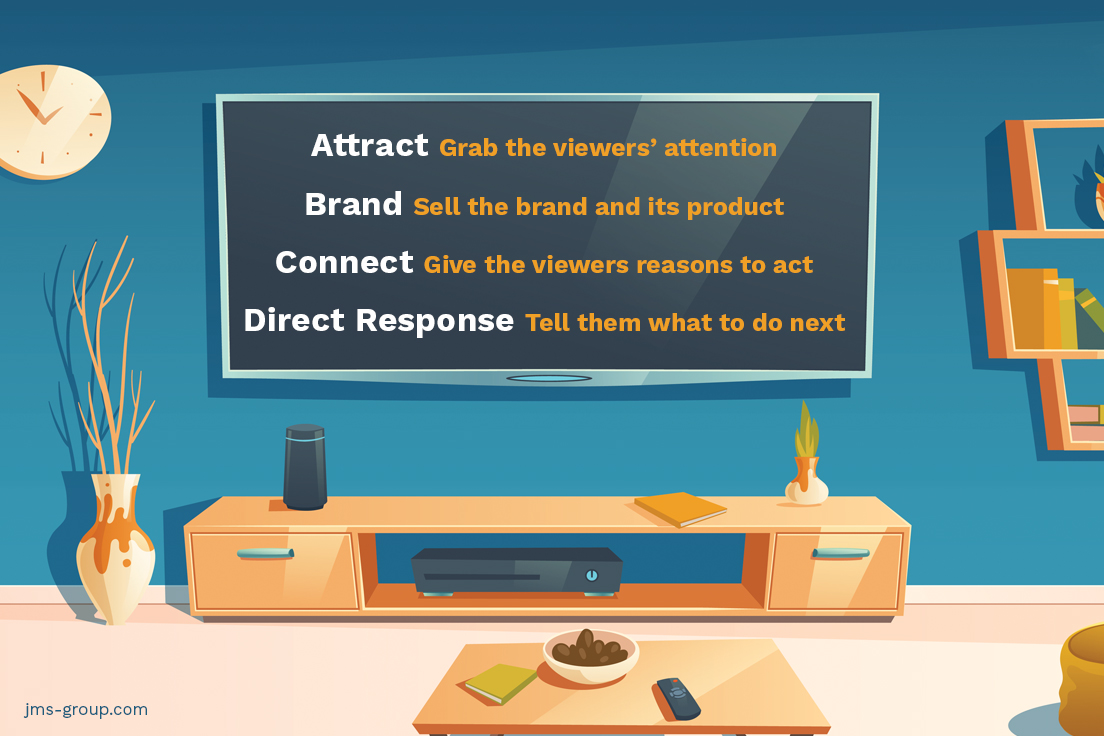
Effective TV commercial production using the ABCD structure. Illustration by upklyak / Freepik
The ABCD structure of a TV commercial is not set in stone (it’s a useful guide) but if a creative concept lacks the elements of being attention grabbing, connecting with its audience, making a great case for purchasing the advertiser’s product, and pushing the viewer to take a specific action… well, the concept likely has more style than substance. Creativity and pleasing visual design are essential attributes that should be woven into a good TV commercial, but never to the detriment of the overriding objective: Successful television ads must function as effective sales tools!
Five: Gain Script Clearance
What Is Clearcast, and What Is Clearcast Approval?
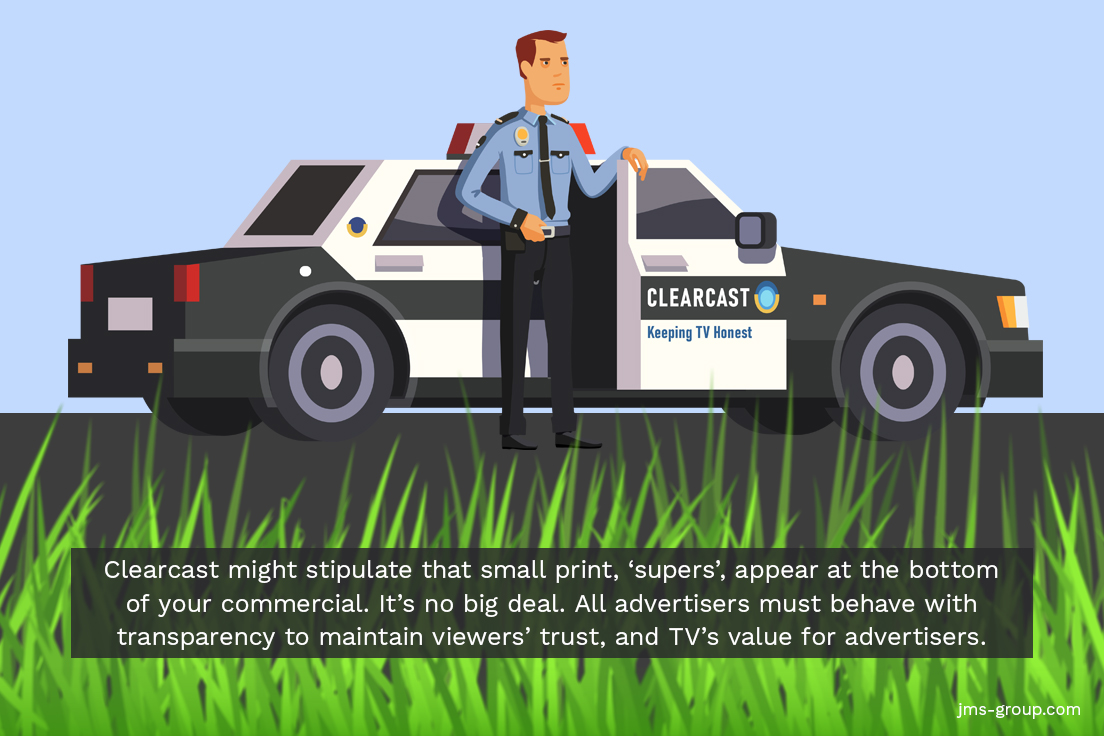
What is Clearcast Clearance? Illustration by iconicbestiary / Freepik
Earlier, I was banging on about TV advertising’s trustworthy reputation. Television’s value to advertisers relies on that high level of trust being maintained. Clearcast is a body funded by major broadcasters to police UK advertising laws (published and enforced by the Advertising Standards Authority) where they pertain to television commercials. Clearcast is a firewall between the hyperbolic claims of sub-par advertisers and TV viewers (it also protects the broadcasters’ interests; their airtime rate cards rely on the medium maintaining its value). Clearcast keep the riffraff out of the commercial breaks.
So, how does the advertising clearance process work? We will get the process underway as soon as we have a script ready to take into production, at this point we will submit the script for Clearcast script approval; a critical (unavoidable) step sometimes missed by inexperienced producers. It is a whole lot easier to make an adjustment to a commercial before it gets produced! At the script approval stage Clearcast will highlight any potentially contentious claims and request adequate substantiation to be supplied to them by the advertiser.
If you are advertising a toothpaste that claims to whiten teeth more than other brands—and that 80% of dentists use it themselves—Clearcast would need to be provided with the scientific papers that prove its efficacy, and details of the research studies that prove 80% of dentists really DO use it themselves! Clearcast might request that studies be repeated at a larger scale; 80% of a survey of 10 dentists just isn’t going to hold water!
Legitimate advertisers have no problem providing substantiation of their products and services. In most cases it’s as simple as confirming that a ‘special offer’ price is a genuine time-limited discount, and that the advertiser has enough stock to meet demand during the run of the campaign.
Clearcast might insist that small print (known in the business as ‘supers’) appear across the bottom of your commercial. This text must meet Clearcast specs for size, legibility, and duration on screen. Some new advertisers feel supers intrude on their commercial’s creative elements and try to negotiate the wording but honestly, don’t worry them. Next time you watch TV make a deliberate effort to look at the lower third of the screen throughout the ad break. Almost every commercial will have some type of super, you just hadn’t noticed. They’re no biggie, and you’re not being unfairly penalised in any way.
Six: Produce the Commercial
Finally! You’ve agreed the creative concept with your commercial production company, you’ve got your script through Clearcast, your airtime is booked, and now you’ve got a timeline for production! So… how do you make a TV ad?
Production is often (perhaps surprisingly) one of the more straightforward elements of a television campaign. With your script locked down and the storyboard decided, the production process of your commercial will be much like that of any other.
How to Shoot a Commercial for TV
Big branding campaigns often have all the bells and whistles (and expense) involved in shooting feature films. However, DRTV commercials often work with smaller production budgets and tighter deadlines than brand-led campaigns, which is why the narrative of a Direct Response commercial often plays out in just one or two locations. To make the most efficient use of the cast, crew, and location we will usually aim to shoot a commercial within a single day— two days at most. Post-production editing and the creation of motion graphics for the commercial will often take several more days to create. A professional voiceover will then need to be recorded, and the soundtrack mixed to broadcast specification.
How to Produce a TV Commercial With Graphics
Graphics is a broad umbrella that can cover an almost infinite variety of styles, each with their own complexity, and each requiring widely different investments of creation time. For the purposes of lower-budget TV commercials we can safely assume the word refers to ‘motion graphics’ (mo-graph) which is the addition of creative movement to otherwise static artwork, logos, pre-existing images, and text.
If you are advertising products—where physical appearance and functionality are the key selling points—the case for filming an ad is clear-cut. Car commercials show the actual car, because an attractive drawing of the car is not what the manufacturer is trying to sell! Yet many advertisers—even gigantic ones—often use nothing but graphics in their TV advertising. Graphics can be especially suited to selling services (i.e., where there is no physical product to point a camera at).
Graphics also provide flexibility for campaigns likely to require future changes to their messaging. Shooting storyboarded footage to fit a pre-written script can ‘set in stone’ many elements of a commercial, which can sometimes limit options for future tweaks—or at least require some editorial compromises to be made. However, every element of a motion-graphics commercial can be altered at relatively short notice.
Long story short: Many factors can limit what can be filmed within your production’s budget, but the options for commercials produced with software are infinite.
Seven: Deliver to the Broadcasters
The finished commercial must be viewed by Clearcast to ensure it has not deviated from the script that was approved at the beginning of the process. Broadcasters will not transmit commercials without Clearcast approval, so we make allowance for this process in the production timeline. Most of the time Clearcast approval is smooth-sailing (we keep them informed of any changes made to the script during production), but sometimes minor adjustments need to be made to get the commercial signed-off.
Back when I began producing TV ads there was only one way to get an approved commercial to broadcasters: Putting multiple videocassettes in the post! This was a process plagued by potential mishaps and was especially stressful as deadlines loomed. Today your commercial will be delivered to all the channels in your media plan via a media logistics company. We use one of the largest, Peach. We will upload the final master of your commercial to Peach (using a regular web browser) and their automatic quality control system will check the video file conforms to broadcast specifications before delivering to the file into the transmission chain at the channels airing your commercial.
In Summary
TV advertising remains an effective, trustworthy, and high-status advertising medium that—despite its immense power—has become increasingly affordable and accessible for businesses of all sizes. Television advertising has relentlessly moved with the times, even creating new delivery technologies to benefit advertisers. On Sky’s AdSmart, commercials are seamlessly inserted into the only most appropriate viewers’ video streams, and that addressability translated into low wastage and exceptionally detailed campaign reporting.
Modern commercial production companies (did I mention JMS Group?) are adept at tailoring concepts and production resources to meet the objectives of your campaign, and that usually means effective TV commercials can be produced within almost any budget.
In addition to all the other great reasons to embark on a TV campaign, there’s still something special about being able to say, “As seen on TV”.
If you’re considering advertising on television in the UK and would like to discuss the options. Drop me a message below.
Tom Vaughan-Mountford is a television advertising producer, video marketing creator, and the author of Managing a Video Production Company. Tom is currently the Senior Editor at JMS Group, a television commercial production company in Norwich, UK. You can connect with Tom on Twitter @tomontv.
